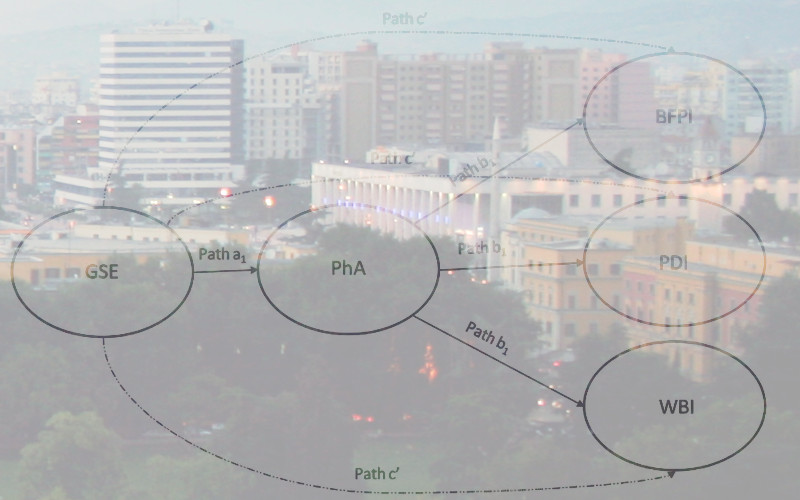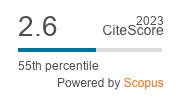Exploring the Mediating Role of Physical Activity in the Relationship between Green Space Exposure and Well-being: Results from the AUGS Survey
DOI:
https://doi.org/10.3097/LO.2024.1126Keywords:
mediation approach, green spaces, mental health, well-being, physical activityAbstract
Although previous studies have shown that exposure to nature has a positive impact on physical and mental health, the factors that produce such benefits are still not well established, especially in high- and middle-income countries. In the present study, we implemented a mediation approach between green space exposure and psychological distress, body fat percentage and well-being index in Tirana (Albania), through the mediation of physical activity. The significant direct effects of green space on body fat percentage index (BFPI), psychological distress index (PDI) and well-being index, together with the relatively smaller mediating role of physical activity, offer insightful implications for the design and prioritization of urban green spaces. The differential impact on health outcomes suggests a complex association that is not only mediated by physical activity, but also offers clear benefits by reducing psychological distress (as indicated by PDI scores) and significantly improving overall well-being. This dichotomy highlights the multifaceted role of green spaces in public health, requiring a broad lens that goes beyond physical health metrics to include mental health and subjective well-being. Our findings also confirm the intrinsic value of green spaces in improving well-being and reducing psychological distress, independent of the physical activities they may promote.
References
Astell-Burt, T., & Feng, X. (2019). Association of Urban Green Space With Mental Health and General Health Among Adults in Australia. JAMA Network Open, 2(7), e198209. https://doi.org/10.1001/jamanetworkopen.2019.8209 DOI: https://doi.org/10.1001/jamanetworkopen.2019.8209
Astell-Burt, T., & Feng, X. (2020). Urban green space, tree canopy and prevention of cardiometabolic diseases: A multilevel longitudinal study of 46 786 Australians. International Journal of Epidemiology, 49(3), 926–933. https://doi.org/10.1093/ije/dyz239 DOI: https://doi.org/10.1093/ije/dyz239
Astell-Burt, T., Mitchell, R., & Hartig, T. (2014). The association between green space and mental health varies across the lifecourse. A longitudinal study. Journal of Epidemiology and Community Health, 68(6), 578–583. https://doi.org/10.1136/jech-2013-203767 DOI: https://doi.org/10.1136/jech-2013-203767
Bai, H., Wilhelm Stanis, S. A., Kaczynski, A. T., & Besenyi, G. M. (2013). Perceptions of Neighborhood Park this is not related to the foundingality: Associations with Physical Activity and Body Mass Index. Annals of Behavioral Medicine, 45(S1), 39–48. https://doi.org/10.1007/s12160-012-9448-4 DOI: https://doi.org/10.1007/s12160-012-9448-4
Barton, J., & Pretty, J. (2010). What is the Best Dose of Nature and Green Exercise for Improving Mental Health? A Multi-Study Analysis. Environmental Science & Technology, 44(10), 3947–3955. https://doi.org/10.1021/es903183r DOI: https://doi.org/10.1021/es903183r
Beyer, K., Kaltenbach, A., Szabo, A., Bogar, S., Nieto, F., & Malecki, K. (2014). Exposure to Neighborhood Green Space and Mental Health: Evidence from the Survey of the Health of Wisconsin. International Journal of Environmental Research and Public Health, 11(3), 3453–3472. https://doi.org/10.3390/ijerph110303453 DOI: https://doi.org/10.3390/ijerph110303453
Bird, M., Datta, G. D., van Hulst, A., Cloutier, M.-S., Henderson, M., & Barnett, T. A. (2016). A park typology in the QUALITY cohort: Implications for physical activity and truncal fat among youth at risk of obesity. Preventive Medicine, 90, 133–138. https://doi.org/10.1016/j.ypmed.2016.06.042 DOI: https://doi.org/10.1016/j.ypmed.2016.06.042
Chen, K., Zhang, T., Liu, F., Zhang, Y., & Song, Y. (2021). How Does Urban Green Space Impact Residents’ Mental Health: A Literature Review of Mediators. International Journal of Environmental Research and Public Health, 18(22), 11746. https://doi.org/10.3390/ijerph182211746 DOI: https://doi.org/10.3390/ijerph182211746
Chiabai, A., Quiroga, S., Martinez-Juarez, P., Suárez, C., García de Jalón, S., & Taylor, T. (2020). Exposure to green areas: Modelling health benefits in a context of study heterogeneity. Ecological Economics, 167, 106401. https://doi.org/10.1016/j.ecolecon.2019.106401 DOI: https://doi.org/10.1016/j.ecolecon.2019.106401
Dzhambov, A., Hartig, T., Markevych, I., Tilov, B., & Dimitrova, D. (2018). Urban residential greenspace and mental health in youth: Different approaches to testing multiple pathways yield different conclusions. Environmental Research, 160, 47–59. https://doi.org/10.1016/j.envres.2017.09.015 DOI: https://doi.org/10.1016/j.envres.2017.09.015
Escolà-Gascón, Á., & Houran, J. (2021). Paradoxical effects of exposure to nature in “haunted” places: Implications for stress reduction theory. Landscape and Urban Planning, 214, 104183. https://doi.org/10.1016/j.landurbplan.2021.104183 DOI: https://doi.org/10.1016/j.landurbplan.2021.104183
Furukawa, T. A., Kessler, R. C., Slade, T., & Andrews, G. (2003). The performance of the K6 and K10 screening scales for psychological distress in the Australian National Survey of Mental Health and Well-Being. Psychological Medicine, 33(2), 357–362. https://doi.org/10.1017/S0033291702006700 DOI: https://doi.org/10.1017/S0033291702006700
Gascon, M., Triguero-Mas, M., Martínez, D., Dadvand, P., Forns, J., Plasència, A., & Nieuwenhuijsen, M. (2015). Mental Health Benefits of Long-Term Exposure to Residential Green and Blue Spaces: A Systematic Review. International Journal of Environmental Research and Public Health, 12(4), 4354–4379. https://doi.org/10.3390/ijerph120404354 DOI: https://doi.org/10.3390/ijerph120404354
Hartig, T., Mitchell, R., de Vries, S., & Frumkin, H. (2014). Nature and Health. Annual Review of Public Health, 35(1), 207–228. https://doi.org/10.1146/annurev-publhealth-032013-182443 DOI: https://doi.org/10.1146/annurev-publhealth-032013-182443
Hayes, A. F. (2018). Partial, conditional, and moderated moderated mediation: Quantification, inference, and interpretation. Communication Monographs, 85(1), 4–40. https://doi.org/10.1080/03637751.2017.1352100 DOI: https://doi.org/10.1080/03637751.2017.1352100
Hayes, A. F., & Montoya, A. K. (2017). A Tutorial on Testing, Visualizing, and Probing an Interaction Involving a Multicategorical Variable in Linear Regression Analysis. Communication Methods and Measures, 11(1), 1–30. https://doi.org/10.1080/19312458.2016.1271116 DOI: https://doi.org/10.1080/19312458.2016.1271116
Huang, Q., Yang, M., Jane, H., Li, S., & Bauer, N. (2020). Trees, grass, or concrete? The effects of different types of environments on stress reduction. Landscape and Urban Planning, 193, 103654. https://doi.org/10.1016/j.landurbplan.2019.103654 DOI: https://doi.org/10.1016/j.landurbplan.2019.103654
Jia, P., Cao, X., Yang, H., Dai, S., He, P., Huang, G., Wu, T., & Wang, Y. (2021). Green space access in the neighbourhood and childhood obesity. Obesity Reviews, 22(S1). https://doi.org/10.1111/obr.13100 DOI: https://doi.org/10.1111/obr.13100
Johnson, B. S., Malecki, K. M., Peppard, P. E., & Beyer, K. M. M. (2018). Exposure to neighborhood green space and sleep: Evidence from the Survey of the Health of Wisconsin. Sleep Health, 4(5), 413–419. https://doi.org/10.1016/j.sleh.2018.08.001 DOI: https://doi.org/10.1016/j.sleh.2018.08.001
Kondo, M., Fluehr, J., McKeon, T., & Branas, C. (2018). Urban Green Space and Its Impact on Human Health. International Journal of Environmental Research and Public Health, 15(3), 445. https://doi.org/10.3390/ijerph15030445 DOI: https://doi.org/10.3390/ijerph15030445
Lavallee, K. L., Zhang, X. C., Schneider, S., & Margraf, J. (2021). Obesity and Mental Health: A Longitudinal, Cross-Cultural Examination in Germany and China. Frontiers in Psychology, 12, 712567. https://doi.org/10.3389/fpsyg.2021.712567 DOI: https://doi.org/10.3389/fpsyg.2021.712567
Markevych, I., Schoierer, J., Hartig, T., Chudnovsky, A., Hystad, P., Dzhambov, A. M., de Vries, S., Triguero-Mas, M., Brauer, M., Nieuwenhuijsen, M. J., Lupp, G., Richardson, E. A., Astell-Burt, T., Dimitrova, D., Feng, X., Sadeh, M., Standl, M., Heinrich, J., & Fuertes, E. (2017). Exploring pathways linking greenspace to health: Theoretical and methodological guidance. Environmental Research, 158, 301–317. https://doi.org/10.1016/j.envres.2017.06.028 DOI: https://doi.org/10.1016/j.envres.2017.06.028
Orru, K., Orru, H., Maasikmets, M., Hendrikson, R., & Ainsaar, M. (2016). Well-being and environmental quality: Does pollution affect life satisfaction? Quality of Life Research, 25(3), 699–705. https://doi.org/10.1007/s11136-015-1104-6 DOI: https://doi.org/10.1007/s11136-015-1104-6
Pretty, J., Peacock, J., Hine, R., Sellens, M., South, N., & Griffin, M. (2007). Green exercise in the UK countryside: Effects on health and psychological well-being, and implications for policy and planning. Journal of Environmental Planning and Management, 50(2), 211–231. https://doi.org/10.1080/09640560601156466 DOI: https://doi.org/10.1080/09640560601156466
Pretty, J., Peacock, J., Sellens, M., & Griffin, M. (2005). The mental and physical health outcomes of green exercise. International Journal of Environmental Health Research, 15(5), 319–337. https://doi.org/10.1080/09603120500155963 DOI: https://doi.org/10.1080/09603120500155963
Rajan, T., & Menon, V. (2017). Psychiatric disorders and obesity: A review of association studies. Journal of Postgraduate Medicine, 63(3), 182. https://doi.org/10.4103/jpgm.JPGM_712_16 DOI: https://doi.org/10.4103/jpgm.JPGM_712_16
Richardson, E. A., & Mitchell, R. (2010). Gender differences in relationships between urban green space and health in the United Kingdom. Social Science & Medicine, 71(3), 568–575. https://doi.org/10.1016/j.socscimed.2010.04.015 DOI: https://doi.org/10.1016/j.socscimed.2010.04.015
Sander, H. A., Ghosh, D., & Hodson, C. B. (2017). Varying age-gender associations between body mass index and urban greenspace. Urban Forestry & Urban Greening, 26, 1–10. https://doi.org/10.1016/j.ufug.2017.05.016 DOI: https://doi.org/10.1016/j.ufug.2017.05.016
Sarwer, D. B., & Polonsky, H. M. (2016). The Psychosocial Burden of Obesity. Endocrinology and Metabolism Clinics of North America, 45(3), 677–688. https://doi.org/10.1016/j.ecl.2016.04.016 DOI: https://doi.org/10.1016/j.ecl.2016.04.016
Stark, J. H., Neckerman, K., Lovasi, G. S., Quinn, J., Weiss, C. C., Bader, M. D. M., Konty, K., Harris, T. G., & Rundle, A. (2014). The impact of neighborhood park access and quality on body mass index among adults in New York City. Preventive Medicine, 64, 63–68. https://doi.org/10.1016/j.ypmed.2014.03.026 DOI: https://doi.org/10.1016/j.ypmed.2014.03.026
Sugiyama, T., Leslie, E., Giles-Corti, B., & Owen, N. (2008). Associations of neighbourhood greenness with physical and mental health: Do walking, social coherence and local social interaction explain the relationships? Journal of Epidemiology & Community Health, 62(5), e9–e9. https://doi.org/10.1136/jech.2007.064287 DOI: https://doi.org/10.1136/jech.2007.064287
Taylor, L., & Hochuli, D. F. (2017). Defining greenspace: Multiple uses across multiple disciplines. Landscape and Urban Planning, 158, 25–38. https://doi.org/10.1016/j.landurbplan.2016.09.024 DOI: https://doi.org/10.1016/j.landurbplan.2016.09.024
Topp, C. W., Østergaard, S. D., Søndergaard, S., & Bech, P. (2015). The WHO-5 Well-Being Index: A Systematic Review of the Literature. Psychotherapy and Psychosomatics, 84(3), 167–176. https://doi.org/10.1159/000376585 DOI: https://doi.org/10.1159/000376585
Tsai, W.-L., Floyd, M. F., Leung, Y.-F., McHale, M. R., & Reich, B. J. (2016). Urban Vegetative Cover Fragmentation in the U.S. American Journal of Preventive Medicine, 50(4), 509–517. https://doi.org/10.1016/j.amepre.2015.09.022 DOI: https://doi.org/10.1016/j.amepre.2015.09.022
Ulrich, R. S. (1983). Aesthetic and Affective Response to Natural Environment. In I. Altman & J. F. Wohlwill (Eds.), Behavior and the Natural Environment (pp. 85–125). Springer US. https://doi.org/10.1007/978-1-4613-3539-9_4 DOI: https://doi.org/10.1007/978-1-4613-3539-9_4
Ulrich, R. S., Simons, R. F., Losito, B. D., Fiorito, E., Miles, M. A., & Zelson, M. (1991). Stress recovery during exposure to natural and urban environments. Journal of Environmental Psychology, 11(3), 201–230. https://doi.org/10.1016/S0272-4944(05)80184-7 DOI: https://doi.org/10.1016/S0272-4944(05)80184-7
Ward Thompson, C., Roe, J., Aspinall, P., Mitchell, R., Clow, A., & Miller, D. (2012). More green space is linked to less stress in deprived communities: Evidence from salivary cortisol patterns. Landscape and Urban Planning, 105(3), 221–229. https://doi.org/10.1016/j.landurbplan.2011.12.015 DOI: https://doi.org/10.1016/j.landurbplan.2011.12.015

Downloads
Published
How to Cite
Issue
Section
Categories
License
Copyright (c) 2024 Samel Kruja, Olta Braçe, Marco Garrido Cumbrera, Elena Kokthi

This work is licensed under a Creative Commons Attribution 4.0 International License.










